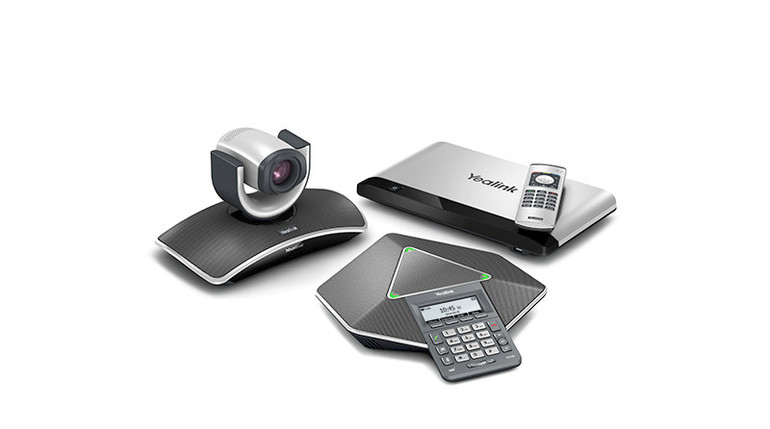Tried-and-true tips for setting up your Yealink VCS video conferencing system.
Step one: buy the video conferencing system. Step two: set it up. The first step can be accomplished with a few mouse clicks. The second step, from unboxing to operation, is where a lot of people stumble.
Setting up the Yealink VC series video conferencing systems is hassle-free. Connect the components, turn on the power and let the setup wizard do the work. Adopting video conferencing has never been more simplified, especially for businesses that are brand new to these solutions.
We tested out this installation process on our own. Our technicians’ jobs have never been so easy or (don’t tell them we said this) non-essential.
The Yealink VC400 video conferencing system and Yealink VC120 video conferencing system offer features like intelligent firewall traversal, anti-packet loss and adaptive bandwidth technology to improve network performance. The result is greater network interoperability, and better audio and video quality, where other systems can be difficult to manage or fail to deliver results.
Optimizing your network to smoothly handle video and multimedia communications is important—the systems can’t do it all! Otherwise, your audio and video will be distorted, patchy or completely unintelligible.

An overview of the Yealink VCS
Before we jump into some ways to reinforce your network, let’s look at the Yealink VCS video conferencing systems. The series includes the Yealink VC400 and VC120, with the former offering an embedded multipoint control unit.

Everything you need for video conferencing is prepackaged with the Yealink VCS systems. No licensing or additional components required. All the features listed above are ready to go, right out of the box.
The Yealink VCS systems include a codec, camera, speakerphone and remote control, plus the power supply, cables and installation hardware. Like we said earlier: connect all of the components, turn on the power and start the system’s setup wizard. It’s that easy!

Intelligent firewall traversal
One feature onboard the systems is intelligent firewall traversal. With this feature enabled, the system make outgoing calls regardless of current firewall settings. The system might not be able to receive incoming calls, however. If this is the case, you’ll need to configure the firewall appropriately.
Troubleshooting the firewall and router
The Yealink VCS’ setup wizard will display firewall port mapping information. When port forwarding is required, make sure the firewall and router allow the Yealink VCS access to these ports (ports typically attributed to the Yealink VCS):
- H.323 signal: port 1720 (TCP)
- A/V stream: port 50000-50499 (TCP/UDP)
- Optional remote management: port 443 (TCP)
- Optional SIP connectivity: port 5060-5061 (TCP/UDP)
If connectivity problems persist, you may have to manually enter an IP address. Normally, the system will automatically receive an IP address from the network or DHCP server.
Enter the IP address by following:
Menu > Advanced (enter password) > NAT/Firewall

Quality of service
Great, your video conferencing system works! You’ve called the Yealink Demo Site and everything seems to check out. A few minutes or just a couple of seconds into the call, you notice that the video and audio quality starts to degrade until its completely unusable for communications.
Rule #1: make sure your system has enough bandwidth
Your network’s a highway of information. If there’s too much traffic, your information will be late or show up sporadically. The data will move at a steady pace, but will be competing for room or take slower, alternate routes.
Bandwidth is like the lanes on your network and video conferencing systems are like huge 18-wheelers coming down the highway—they take up a lot of space on the network. For optimal performance, you want the video and audio to have a smooth lane to and from your video conferencing system.

Packet loss, latency and jitter
Quality of service refers to how well your equipment performs with your network. Quality of service, or “QoS,” isn’t unique to the Yealink VCS. It’s a term used across all IP devices, including phones, surveillances cameras, network switches and so on and so on.
You can watch a video conference and quickly determine whether the quality is perfect, so-so, or just plain awful. Our technicians use terminology like “packet loss,” “latency” and “jitter” to measure for quality of service.
Packet loss: when packets of audio and video data are lost in transmission. Data departs one point and does not arrive at the destination point. Video can appear pixelated, or audio will drop in and out.
Latency: how long it takes for data packets to be received. Heavy or congested traffic will increase latency, while smoothly running networks will have no latency.
Jitter: networks have an average latency and jitter tells you how much the latency is deviating from this measurement. For example, if audio is arriving on time, but video is late, then voices and lip movements will not match.

Troubleshooting calls on the Yealink VCS
Problems with QoS can affect your video conferences. If the video appears pixelated or voice are difficult to understand, check the network conditions. You can do this during a call!
While the call is in progress, go to More>Call Statistics in the Yealink VCS menu. The system can measure bandwidth usage, packet loss, jitter and more.
Typically, the Yealink VCS requires the following amount of bandwidth:
- For video in 1080p HD: 1Mb
- For video in 720p HD: 512Kb
The Yealink VC series video conferencing systems utilize adaptive bandwidth and dynamic bandwidth adjustment to resist problems due to packet loss. The result is clear pictures, regardless of network problems. However, severe traffic problems are irreconcilable by the systems.
Yealink has been a dominating force in the VoIP phone industry. They rank as the second most popular SIP phone manufacturer in the world. Now they’ve entered the video conferencing market and their new video conferencing systems are certainly making a statement.

